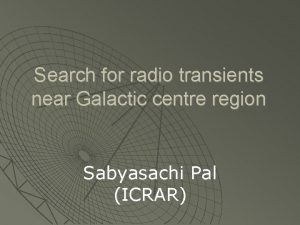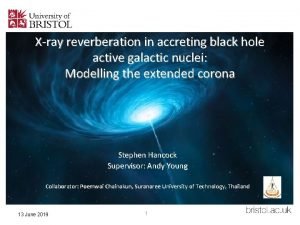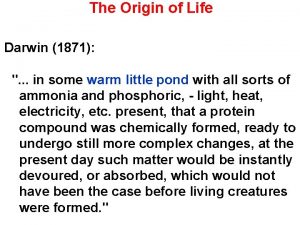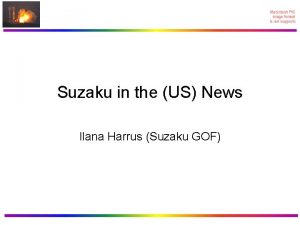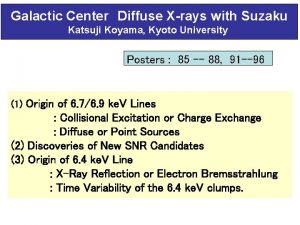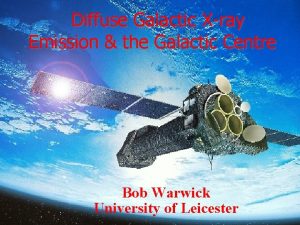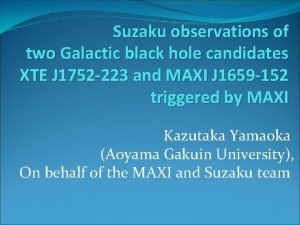The Suzaku Images of the Galactic Center Xray







- Slides: 7

The Suzaku Images of the Galactic Center X-ray Emission (GCXE) Average spectrum of the GCXE (Uchiyama+13) S XV Kα Fe I Kα Fe XXV Kα Spatial distribution of the GCXE and stars (Uchiyama+11) X-ray surface brightness of Fe XXV Kα factor 3 -4 of discrepancy • Strong Fe XXV Kα, S XV Kα, and Fe I Kα the GCXE consists of High Temperature Plasma (HP), Low Temperature Plasma (LP), and Cold Gas. • The GCXE is not integral emission of unresolved X-ray stars.

1 X-ray Reflection Nebula (XRN): Echo of Past Sgr A* Flares Variable XRN Sgr B 2 (Nobukawa+11) 700 yr activity history of Sgr A* (Ryu+13) Line of sight Positions of XRNe (Ryu+13) Suzaku and other satellites found time variability of Fe I Kα and hard X-ray from molecular clouds (MCs, e. g. Muno+07, Inui+09, Ponti+10). à X-ray light echoes of past flares of super massive black hole Sgr A* at the center of our Galaxy. à Key information for activity history of Sgr A*. Accurate past light curve of Sgr A* (in time and fluxes) depends on 3 -d distribution of the MCs (e. g. Ryu+13).

2 -2 Hint of a RP from a Close Vicinity of Sgr A* Suzaku spectrum near Sgr A* (l = 0°. 1, b = -0°. 1) If Sgr A* was very active about a few 105 years ago as is suggested by the GC south plasma, it might also leave a RP at a close vicinity of Sgr A*. Suzaku found a hint of RP near Sgr A* (l = 0°. 1, b = -0°. 1 ). The plasma also shows a hint of Compton shoulder of the 6. 4 ke. V line. • The fitting of a CIE plasma model leaves residuals at ~ 6. 7 ke. V and ~ 6. 3 ke. V. • RP model and Compton shoulder of the 6. 4 ke. V line significantly improve the fitting.

New Sciences of the GCXE to be unveiled by ASTRO-H Proposed 3 positions overlaid on Suzaku XIS images Fe XXV Kα line image (3) GC West Fe I Kα line image (3) GC West (1) Sgr A* (2) GC East HXI FOV SXS FOV o. 2 0. 1 0. 0 -0. 1 -0. 2 (deg) Galactic longitude 10 pc o. 2 0. 1 0. 0 -0. 1 -0. 2 (deg) Galactic longitude We propose three pointing observations, which play complementary roles. (1) The Sgr A* region is for the study of Sgr A* and its vicinity. (2) The GC East region is the strongest in Fe I Kα (XRN) (“MC 1” in Ponti+10). (3) The GC West is the region of pure HP and LP components with no bright XRN.

Suzaku spectrum shows a hint of the 1. Accurate History of Past Sgr A* Flares SXS simulation spectrum of (2) – (3) Compton shoulder of Fe I Kα. We can obtain pure Fe I Kα spectrum by subtracting (3) GC West data from (2) GC East data. Fe I Kα Fe I Kβ The shape of the Compton shoulder gives 3 -D position of the MC. Then we can obtain more accurate light curve of Sgr A*. Compton shoulder of Fe I Kα In a photo-ionized plasma formed by a past Sgr A* flare, the temperature ratio of ionization (k. Tz) to electron (k. Te) should be higher near Sgr A*. We can see the difference of k. Tz/k. Te between (1) Sgr A* and (3) GC West regions. 2. Plasma Diagnostic for Sgr A* Activities SXS simulation spectrum of (1) vs. (3) Sgr A* region (k. Tz/k. Te = 3. 0) GC West (k. Tz/k. Te = 1. 5) Fe XXV Kα complex CIE Fe XXVI Lyα k. Tz/KTe= 1. 0 RP 1. 5 3. 0 G ratio (x+y+z) 0. 70± 0. 04 0. 88± 0. 04 1. 84± 0. 07 /w

3. Non Thermal Emission and a Coming Sgr A* Flare SXS & HXI wide-band simulation spectrum from (1) High-quality spectra of the GCXE with SXS/SXI/HXI give us the first opportunity to investigate • exact nature of hard X-ray (possibly non-thermal) emission with no energy gap between 0. 5 and 50 ke. V. • coming flare of the nearest massive black hole Sgr A* (Gillesen et al. 2012). SXS simulation spectrum of (1), (2), and (3) 4. Dynamics of the GCXE Plasma and XRNe Fe XXVI Lyα 1 & Lyα 2 100 km/s red shift (1) (2) 50 km/s blue shift 200 km/s broadening (3) Doppler shift of the GCXE lines tell the dynamics of the GC plasma and XRNe. the same Galactic rotation curves as stars ? Do they show

5. The GC: a Treasure Box in Astrophysics We have made many “unexpected” discoveries from the GC with Ginga, ASCA, and Suzaku, such as the GCXE, XRNe, RP and etc. The high-quality spectra of ASTRO-H will surely provide new “unexpected” discoveries, because the GC is full of mystery and a treasure box in astrophysics.
